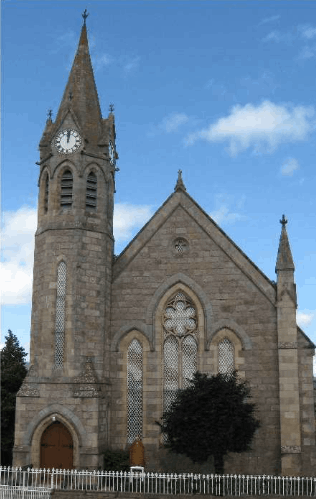There is a long coffin slab in St Drostan’s Kirkyard in High Street by the gable wall of the old church which is one of the oldest lettered stones in Scotland. The inscription (said by some authorities to be in Irish characters) – “ Orate pro anima radulfi sacerdotis” with a Maltese Cross below. “Pray for the soul of Radulf, the priest”. This is probably the gravestone of Radulf, a Chaplain of the Bishop of Aberdeen who witnessed a grant of land in the parish of Rayne to the convent of Melrose about 1172 - 99. One expert says that Radulf was probably Bishop of Aberdeen for 8 years and died in 1247. So there seems to have been a graveyard in the area by that time.
There is a list of ministers from 1567 recorded at the back of a minute book 1923 – 1983. St Drostan’s Church, High Street. One of those ministers, Mr. Calderwood, appeared in a cartoon in a church bulletin dated the 4th December 1945. Under it was a paragraph about his reputation as a keen walker. He was known as “The Walking Parson.” The article stated, “He likes to tell this story against himself - at Insch he found territory after his own heart for walking. Two of his parishioners saw him set out one day. ‘The new Minister’s an awfu tramp,’ said one, admiring his prowess. ‘Thirty miles a day is naethin tae him. He maun hae tae guid feet.’ The other, less ardent in her admiration, sniffed and said, ‘Aye, that end o him seems aa right!” The same can be said of the present minister who is often to be seen walking with or without her two labradors!
St. Drostan's Church, High Street gable with its bellcote remains in the kirkyard in High Street. It has the date 1613 on it and MJL the initials for Minister John Logie. It served until 1882 when the building was condemned.
At the Kirk Session meeting in the public hall on the 1st of December 1883, the minute states, “The Session recorded their gratification that the new Church was now occupied by the congregation.” The present Insch Parish Church has four beautiful stained glass windows along one wall side and another two beautiful stained glass windows from Oyne Church have been cleverly hung on the front inside wall of the church. These two windows have lights behind them which, when switched on, show the colours to their full glory. The Church Hall, opened in 1901, is situated directly across from the Church.
Insch West Church (United Free Church) was built in 1852. Insch West Church and Insch East Church united in 1940 after which the building was used as an egg grading station, and was sold in 1947. The site is now the fire station.



